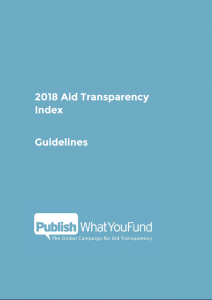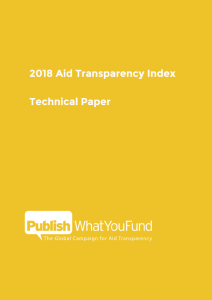The 2018 Aid Transparency Index methodology is here
The Aid Transparency Index is the only independent measure of aid transparency among the world’s major aid organisations. To date, it has contributed to raising 25% of global aid to a high enough standard to be useful and used by others. The Index continues to influence donors to publish high quality aid and development information to a common standard – the International Aid Transparency Initiative (IATI). This means it can be shared, used and reused – saving time and money for both donor and recipient governments and allowing civil society to hold them accountable.
As we have outlined in previous blog posts over the last eight months, we have undertaken an in-depth methodology review and consultation process. This process has now been completed and the revised Index methodology is available. The changes are outlined in the 2018 Aid Transparency Index Guidelines document and the new methodology outlined in full detail in the 2018 Aid Transparency Index technical paper. There are three key points that have come out of the methodology review:
- The consultation has made the methodology more robust. It encourages donors to publish more and better quality information where there are gaps or where the information is most useful.
- Index partners and survey respondents told us that they wanted more and better data on certain indicators such as sub-national locations, project objectives and results. To address this concern, we have put more emphasis on these pieces of information over others, and changed the weighting of the Index to reflect that.
- We have also made some changes to the sampling process used to verify data published to certain fields in the IATI Standard. We have added titles and descriptions to the list of activities sampled, and increased the number of activities sampled from ten to 20 for each indicator.
- We built these recommendations on wide consultations throughout the methodology review process and incorporated important feedback.
- Since October 2016, we have received submissions from over 60 organisations in ten countries including donors, civil society groups, development experts and partner country governments.
- The feedback led us to implement a number of changes to the Aid Transparency Index methodology and refine our initial proposal in the process.
- We know how important it is to communicate clearly and transparently all aspects of the Index methodology, including the tests that we run to calculate the scores. We have updated our technical paper and developed some guidelines to address this.
- We will not be implementing a visibility measurement in the next Index but remain committed to it and will continue to work on this important area.
- The IATI Standard is the only open global standard for the publication of timely, comprehensive, disaggregated and forward looking data on aid and development finance. Respondents agreed that we should therefore measure the proportion of a donor’s portfolio that is published in the IATI Standard as part of the Index methodology.
- We identified several ways to do this, but implementation is problematic due in part to differences in budget cycles, unpredictable funding of some organisations and lack of consistent data quality.
- We remain committed to this principle, but will only implement it when the methodology for doing so is more robust. We intend to share what we have learned with donors and the broader transparency community and to continue to seek an effective solution for a future Index.
We will announce in August which organisations will be included in the 2018 Index – based on a revised criteria – along with a timeline for data collection. Data collection is scheduled to begin in the final quarter of 2017, with the next Aid Transparency Index due be published in the second quarter of 2018. We are grateful to everyone who has taken part in the methodology review and look forward to starting work on the next Index.



